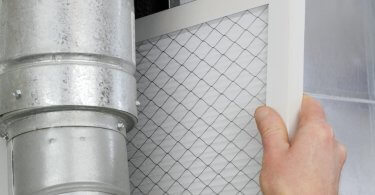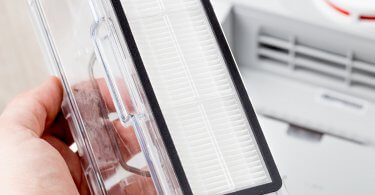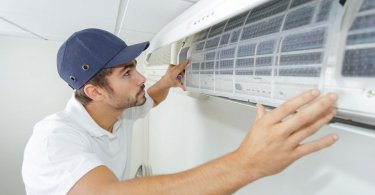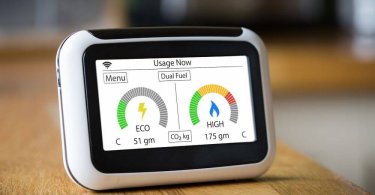Open up your windows and take a deep breath of fresh air. Now close the windows and take another deep breath. How does that compare?
Unfortunately, the quality of inside air is often much worse than outdoor air quality. You may not be aware of the dangers of a lack of indoor air quality. Poor indoor air quality can trigger respiratory diseases.
We spend so much time indoors, that being aware of the IAQ (indoor air quality) is important. But which room has the worst indoor air quality? Is it the kitchen where all the cooking fumes are? Or maybe it’s the bathroom because of indoor air pollutants? It turns out, the laundry room is the room with the worst indoor air quality.

Which Room Has The Worst Indoor Air Quality?
Did you know that the room in your house with the worst indoor air quality (IAQ) might not be what you think? Most people believe that it’s the kitchen or bathroom because of all the cooking and cleaning in these rooms. However, the room with the worst air quality is the laundry room.
The major contributing factor to this poor air quality is the chemicals released into the air when you do your laundry. These chemicals can include bleach, fabric softener, and detergent.
Also, plenty of dust enters the air when you do laundry and stays there for a while, eventually compromising the air you inhale. Dust mites are tiny creatures living in dust, and they can have adverse health effects on people who are allergic to them. If you have ever had a runny nose or itchy eyes after doing your laundry, you probably experienced an allergic reaction to dust mites.
To improve your home’s air quality, you should start by changing your laundry routine. Use natural cleaning products instead of harsh chemicals, and keep the room well-ventilated so that dust doesn’t build up.
Other Rooms In the House Where the Indoor Air Quality Is Compromised
It’s easy to take for granted the air we breathe, but the truth is that the quality of indoor air can be far worse than outdoor air quality – even in relatively clean areas. These are the other places in your home where you might have to work on indoor air quality:
1. Bedrooms
Bedrooms are typically one of the most polluted rooms in the house. Here, the main culprits are dust mites, mold, and volatile organic compounds (VOCs) released from building materials like carpeting, paint, and furniture.
Dust mites are tiny creatures that thrive in warm, humid environments – like a typical bedroom. They feed on dead skin cells shed by humans and animals, and their feces contain an allergen that can trigger an asthma attack and other respiratory or lung diseases.
Mold is another common problem in bedrooms – especially if there is a water leak or high humidity levels. Mold releases spores into the air that can cause allergic reactions and respiratory infections.
VOCs are chemicals released by synthetic materials like carpeting, paint, fabric, and adhesives. These chemicals can cause headaches, dizziness, and nausea.
Here are a few things you can do to get rid of indoor pollutants in your bedroom:
- Keep dust levels under control by vacuuming regularly with a HEPA filter and dusting surfaces with a damp cloth. Also read: can you wash a HEPA filter?
- Keep humidity levels low by using a dehumidifier or opening windows for ventilation.
- Reduce VOCs by choosing natural fibers like cotton or wool for bedding and furnishings whenever possible. Avoid scented candles and air fresheners, and ventilate the room when using cleaning products or painting.
Related article: Indoor Air Quality Facts & Statistics
2. The Kitchen
Your kitchen usually has poor indoor air quality – mainly due to cooking fumes, mold, and VOCs from synthetic materials like countertops, cabinets, and flooring.
Cooking fumes contain harmful particulates that can trigger asthma attacks and other respiratory problems.
Mold is often found in kitchens because of insects attracted to food scraps as well as moisture from dishwashing and cooking.
VOCs are also released by synthetic materials used in many kitchens – like countertops made of laminate or composites, as well as cabinets made of particle board or MDF.
Here are some tips you can follow to make your kitchen’s IAQ better:
- Use an exhaust fan when cooking to remove harmful particulates from the air.
- Keep mold under control by cleaning up spills immediately and drying wet areas thoroughly.
- Reduce VOCs by using natural materials like wood or stone for countertops and floors whenever possible.
Related article: 6 Best Air Quality Monitors
3. The Bathroom
Bathrooms are one of the most common places for mold and mildew to grow. This is because bathrooms are generally moist environments due to showers, baths, and sink usage. When mold and mildew spores mix with water vapor in the air, they create a potent mixture that can cause all sorts of respiratory problems, including bronchitis and other respiratory infections.
Another problem with bathrooms is that they’re often small spaces with very little ventilation. This means that any airborne pollutants (including mold spores) will quickly build up, leading to poor air quality.
Here are some viable solutions to fix the indoor air quality in your bathroom:
- Ventilation is key in preventing bathroom mold growth and improving indoor air quality. If your bathroom doesn’t have a window, make sure to open the door after each shower or bath so moist air can escape.
- It’s good to also run an exhaust fan during and after showers to help remove moisture from the air. Be sure to clean your exhaust fan regularly to prevent it from becoming a breeding ground for the mold itself.
- Keep your bathroom clean and dry as much as possible to avoid mold and mildew from taking hold in the first place.
Related article: How to Properly Ventilate a Bathroom Without a Window
4. The Attic
The attic also tends to have poor indoor air quality because it is usually closed off from the rest of the house. This lack of ventilation causes a build-up of house dust mites, pollen, and other allergens, which can trigger respiratory problems in people who suffer from allergies or asthma.
In addition, attics are often home to insulation materials like fiberglass or cellulose, which can release harmful larger particles into the air when disturbed.
If you want to keep your attic air safe to breathe in, here’s what you can do:
- The best way to improve attic air quality is by increasing ventilation by installing a vent fan or opening up a window whenever possible.
- If you’re using your attic for storage, cover any insulation materials with a tarp or other breathable fabric so that you won’t disturb the airborne particles.
- Have your attic professionally cleaned once every few years to remove any accumulated dust and allergens.

Rounding Up
Home is where we come to escape the world and breathe in safety and solace. Therefore, taking steps to ensure the safe indoor air quality in your home is inevitable.
Proper ventilation helps reduce the build-up of chemicals and allergens, which can be harmful if inhaled over time.
Additionally, reducing the use of hazardous chemical products such as bleach and aerosols around the home will contribute to safer indoor air quality.
Overall, understanding what rooms have the worst indoor air quality should be top of mind for anyone looking for ways to improve their home’s health and safety.





Leave a Comment